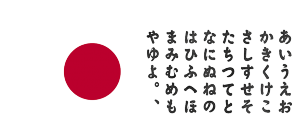Language/Japanese/Pronunciation/Alphabet-and-Pronunciation
Japanese language uses three ways to express sounds and writing ː Hiragana, Katakana and Kanji.
There are to simple symbols tables called "Hiragana" and "Katakana" and the borrowed Chinese characters called Kanji.
Hiragana
Hiragana is the most common. You can find it everywhere, in restaurant, train stations...
| あ | A | か | KA | さ | SA | た | TA | な | NA | は | HA | ま | MA | や | YA | ら | RA | わ | WA | ん | N |
| い | I | き | KI | し | SHI | ち | CHI | に | NI | ひ | HI | み | MI | り | RI | ||||||
| う | U | く | KU | す | SU | つ | TSU | ぬ | NU | ふ | FU | む | MU | ゆ | YU | る | RU | ||||
| え | E | け | KE | せ | SE | て | TE | ね | NE | へ | HE | め | ME | れ | RE | ||||||
| お | O | こ | KO | そ | SO | と | TO | の | NO | ほ | HO | も | MO | よ | YO | ろ | RO | を | WO |
Also, to form some sounds like Z, P or B we have to use some additional symbols to complete basic ones.
゛(dakuten) makes K becomes G, S become Z, T becomes D, H becomes B
゜ (handakuten) makes H becomes P
| が | GA | ざ | ZA | だ | DA | ば | BA | ぱ | PA | |
| ぎ | GI | じ | JI | ぢ | DZI | び | BI | ぴ | PI | |
| ぐ | GU | ず | ZU | づ | DZU | ぶ | BU | ぷ | PU | |
| げ | GE | ぜ | ZE | で | DE | べ | BE | ぺ | PE | |
| ご | GO | ぞ | ZO | ど | DO | ぼ | BO | ぽ | PO |
Notes ː
As you can see, for "W" sound, there are only A and O.
Concerning the "Y" section, there are only A, U and O.
Also, to form some sounds like Z, P or B we have to use some additional symbols to complete basic ones.
゛makes K become G, S become Z, T become D, H become B
゜ makes H become P
The difference between じ and ぢ, ず and づ is if the consonant is voiceless or voiced.
Katakana
Based on the same concept of hiragana, katakana is especially made to translate foreign names and words
| ア | A | カ | KA | サ | SA | タ | TA | ナ | NA | ハ | HA | マ | MA | ヤ | YA | ラ | RA | ワ | WA | ン | N |
| イ | I | キ | KI | シ | SHI | チ | CHI | 二 | NI | ヒ | HI | ミ | MI | リ | RI | ||||||
| ウ | U | ク | KU | ス | SU | ツ | TSU | ヌ | NU | フ | FU | ム | MU | ユ | YU | ル | RU | ||||
| エ | E | ケ | KE | セ | SE | テ | TE | ネ | NE | へ | HE | メ | ME | レ | RE | ||||||
| オ | O | コ | KO | ソ | SO | ト | TO | ノ | NO | ホ | HO | モ | MO | ヨ | YO | ロ | RO | ヲ | WO |
| ガ | GA | ザ | ZA | ダ | DA | バ | BA | パ | PA | |
| ギ | GI | ジ | JI | ヂ | DZI | ビ | BI | ピ | PI | |
| グ | GU | ズ | ZU | ヅ | DZU | ブ | BU | プ | PU | |
| ゲ | GE | ゼ | ZE | デ | DE | ベ | BE | ペ | PE | |
| ゴ | GO | ゾ | ZO | ド | DO | ボ | BO | ポ | PO |
There is a small difficulty in katakana symbols table due to the very similar looking of some ː ノ、ソ、ン、シ、ツ...+ゾ、ジ、ヅ。
Kanji
Kanji makes homonyms to be understood more precisely. For example, kami may means god, paper, hair. With Kanji, one can express the proper meaning.

